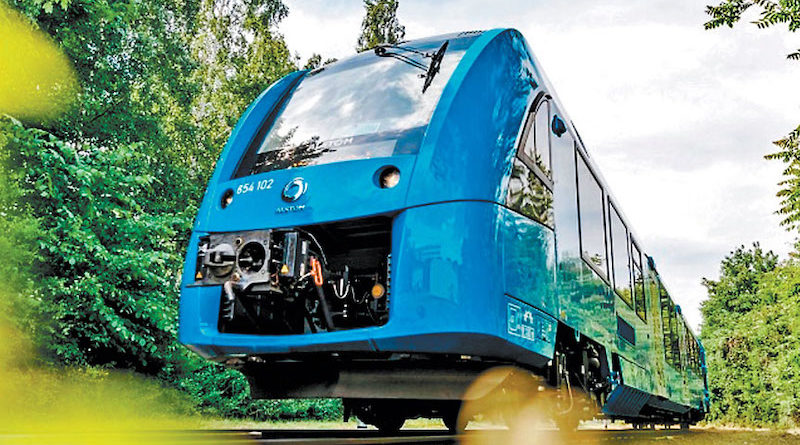
EU Hydrogen at a crossroads: how to gear up?
The Green Deal is a game changer. Reaching climate neutrality by 2050 will require unprecedented efforts by all sectors and transport – accounting for a quarter of the Union’s greenhouse gas emissions – is at the forefront. In its new mobility strategy, the Commission considers that a 90% reduction in transport emissions is necessary, in spite of the fact the sector was still on growing emission trends… until the Covid crisis happened.
The latter exposed our vulnerabilities and reminded us how much transport is the circularity blood system of our European societies. Being vital, the sector needs to find the right balance between accompanying economic growth while transforming itself to become climate-friendly, with tackling as top priority its dependency on fossil fuels.
How? “Clean Hydrogen”, they say. Though the energy itself has been known and used for long, it is finally considered today by EU institutions and Member States as a credible alternative to fossil fuels for the transport sector. More generally, the EU’s recent hydrogen strategy and the extensive investment projected for the sector in some national recovery plans (7 billion euros for France; 9 billion euros for Germany) confirm the new political momentum gathering behind for a hydrogen industry to emerge in Europe.
In these circumstances, can hydrogen square the circle of zero emissions mobility in Europe?
If hydrogen has an indispensable role to play for reaching sustainable mobility, we as policy makers should keep in mind that it is no panacea.
Beyond zero tailpipe emissions, hydrogen is at a crossroads between crucial issues, such as energy, industry, infrastructure, sovereignty even. If those interconnections are not well assessed, they will threaten the potential of a European hydrogen industry, with the risk of turning an old solution into a new problem.
A strategic use of low carbon hydrogen for EU mobility
In the transition towards sustainable mobility, it is interesting to observe from time to time a rediscovery of old technologies. Similar to electric cars, hydrogen production processes have been known for centuries and yet, our cars, trains and aircraft are still not fuelled by it. There are physical and economic reasons explaining why we have not collectively privileged this energy carrier over time: its lack of competitiveness when compared with fossil fuels.
Fossil fuels have been abundant and accessible at low cost, while having a high energy density. Still further, they are easily transportable and storable, especially oil.
On the other hand, the production of hydrogen alone requires expensive infrastructures and substantial amounts of energy. In order to have a low carbon footprint under a life cycle analysis, the bill gets even higher for low-carbon hydrogen by electrolysis, due to its electro-intensive process. As such, using electricity directly will always remain a more valuable cost-beneficial alternative – for passenger cars for instance – than using it first to produce green hydrogen.
Nevertheless, electrification is not always achievable in transport, particularly for heavy mobility. This is where we should concentrate our focus. If the added value of hydrogen for trucks, buses or dustbin lorries still has to be improved, hydrogen is simply indispensable to decarbonise maritime and aviation in the long run. This achievement will be accelerated by considerable research and innovation efforts, which the EU must support further, especially for storage on board vessels and aircrafts (as a reminder, four litters of liquefied hydrogen equal one litter of oil). In rail, hydrogen powered trains could be an alternative for passenger lines that would be too expensive to electrify. Unfortunately, we can only deplore the budgetary cuts affecting these programmes in the new MFF, hampering sufficient European collective ambition for the task in hand.
An EU strategic deployment of low carbon hydrogen
Hydrogen does not only face production energy-efficiency difficulties. It is also a very light gas. Infrastructure-wise, as the volumes to be transported are much greater than with fossils, all existing gas pipelines cannot be used as they currently are; in addition to loses, security and lock-in effect concerns which may arise. Alternatively, transporting hydrogen in liquefied form by boat, for example, requires cooling it to -252°C, which in turn consumes more energy and further degrades its competitiveness.
In both cases, the less hydrogen travels, the more competitive and clean it will be. Imports should therefore be avoided where possible. This is an encouraging aspect which advocates in favour of the emergence of a hydrogen industry on the European soil!
Additionally,
by not transferring our importation dependency from fossil fuels to a new resource, it is our European autonomy strategy as a whole which is strengthened.
However, due to their additional costs, a strategic deployment of hydrogen is needed, with a precise mapping and careful selection of installations. Europe holds strong assets in this regard. Our success will rely on our capacity to establish key hydrogen valleys, such as inland and maritime ports, which are already essential hubs for our energy and industry supplies and offer a strategic leverage for multi/shift-modality.
An EU strategic production of low carbon hydrogen
This being said, the core question to appreciate the climatic and economic advantages of hydrogen remains the source of electricity used. As shown by the taxonomy debates, this is where today’s real challenge lies and where the European approach starts to erode.
Production by electrolysers consumes huge amounts of electricity. The latter must then be produced with low-carbon power capacities to be climate friendly and with high load factors to be competitive. Caught in this vice, nuclear energy – the elephant in the room – appears then as the most valuable option at our disposal, and its exclusion from “clean hydrogen” classification, as a fallacy.
Representing 70% of its electricity mix (for how long though?), nuclear enables France to base its strategy on existing national electricity production and gives more room of manoeuvre to foster its industrial autonomy.
On another hand, Germany, by phasing out nuclear capacities and integrating more intermittent renewable energies, orientates its strategy towards a higher recourse to imports. This approach might solve our territorial emission reduction objective, but it would leave our dependency on third countries intact.
More generally, hydrogen appears here as a case study of the divergences encountered in the energy transition in Europe and questions the compatibility of the different European energy policies. Over the coming decades: the EU expects its electricity needs to drastically increase due to the electrification of whole sectors and activities; it has announced a multiplication of production of low-carbon hydrogen and it plans to face it thanks to the growing inclusion of intermittent renewable energy sources with low load factors. Meanwhile, transmission system operators are already raising the alarm on rising risks of blackout today! In the long run, can such a strategy be considered as credible?
A geostrategic hydrogen: European autonomy at stake
Though hydrogen is no panacea, it remains indispensable to decarbonise some economic activities where there is no substitute, such as heavy mobility for the transport sector. To optimise its potential as an energy carrier, its limits must be realistically assessed, free from ideological concerns. Beyond any rainbow hydrogen classification, all options at our disposal must be considered and appreciated under their life-cycle assessment, including nuclear sources.
As such, a targeted use paired with a strategic deployment in Europe is necessary to maximise its economic and climatic added-value. Nevertheless, due its structural lack of competitiveness, private and public investments must support innovation and contribute to scale up the technological eco-system in order to lower the production costs.
Alongside public mechanisms (such as a carbon border adjustment mechanism or higher CO2 prices), the emergence of a European sector and the rise of European champions will generate high-quality jobs and position the EU as a global standard-setter and world-leading region for hydrogen.
This time, the Union cannot afford to miss the opportunity. For many, the loss of Europe’s industrial leadership on wind turbines or solar PVs remains vividly and painfully in mind. After having called for years to initiate a common strategic autonomy and put an end to a certain “European naivety”, the EU seems to be finally waking up. First and foremost, hydrogen is of geostrategic matter. If we, as Europeans, do not assure an autonomous European industry sector, which secures the full supply chain (including technologies, equipment, materials such as platinum for electrolysers…), we might fail to meet our climate objective and to resolve our long-term vulnerabilities. Time has come for the Union to gear-up!



